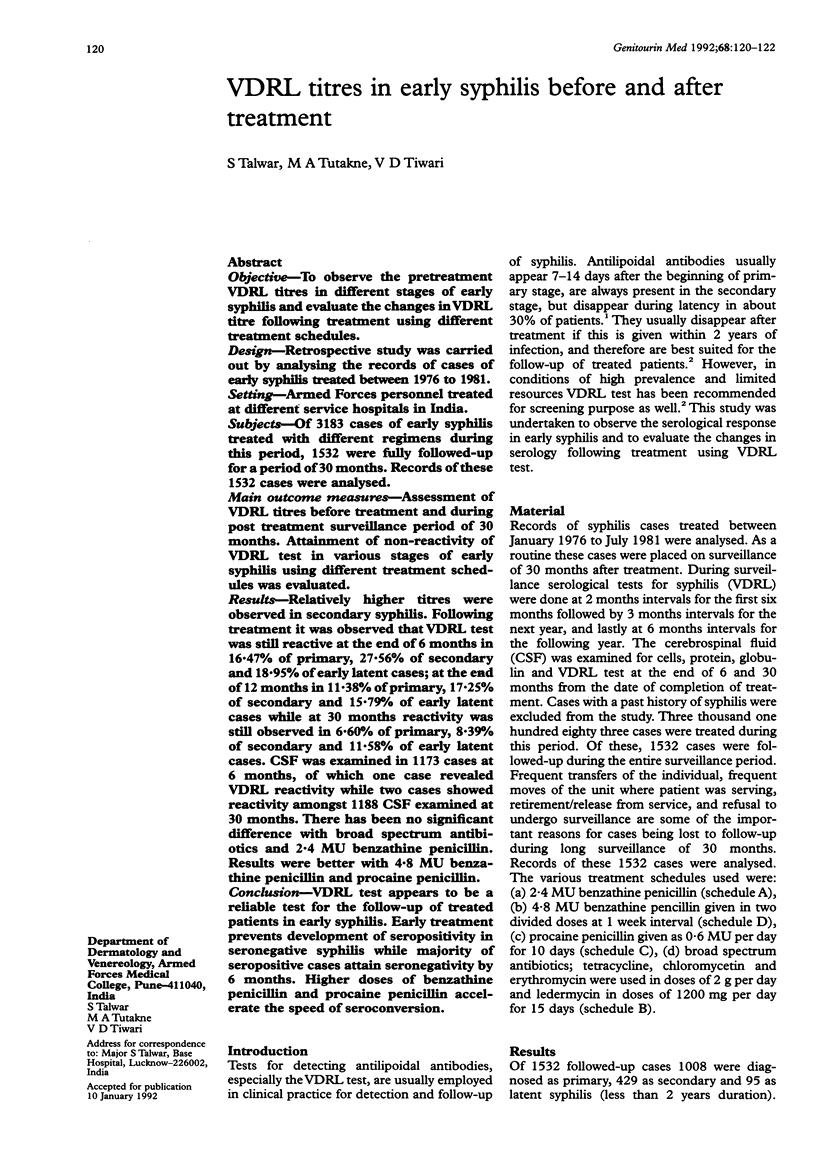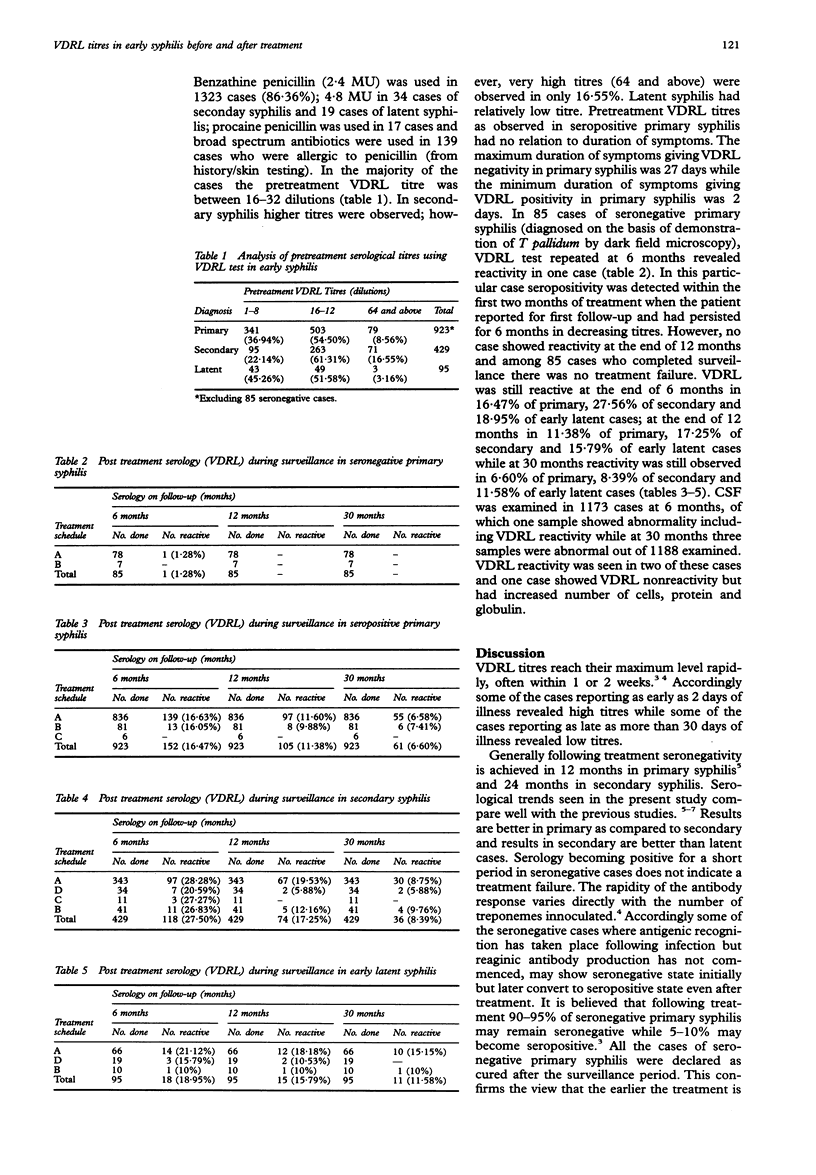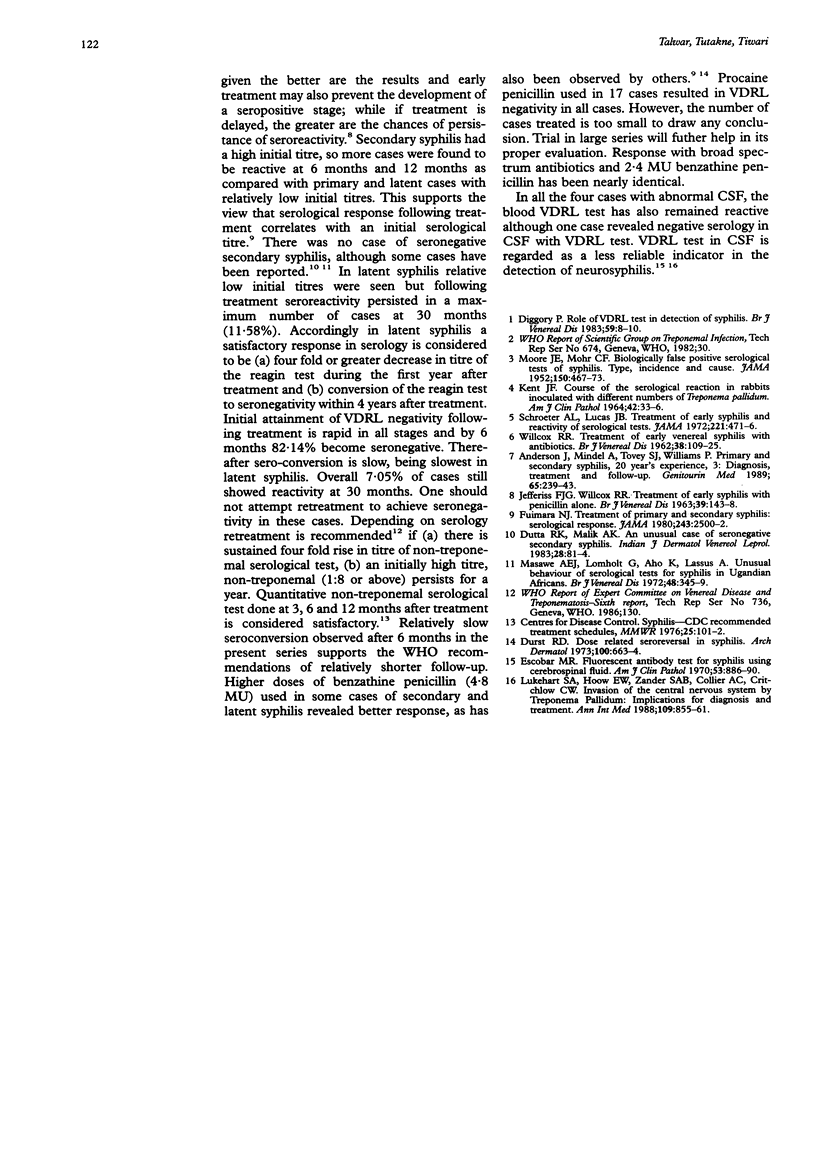Abstract
OBJECTIVE--To observe the pretreatment VDRL titres in different stages of early syphilis and evaluate the changes in VDRL titre following treatment using different treatment schedules. DESIGN--Retrospective study was carried out by analysing the records of cases of early syphilis treated between 1976 to 1981. SETTING--Armed Forces personnel treated at different service hospitals in India. SUBJECTS--Of 3183 cases of early syphilis treated with different regimens during this period, 1532 were fully followed-up for a period of 30 months. Records of these 1532 cases were analysed. MAIN OUTCOME MEASURES--Assessment of VDRL titres before treatment and during post treatment surveillance period of 30 months. Attainment of non-reactivity of VDRL test in various stages of early syphilis using different treatment schedules was evaluated. RESULTS--Relatively higher titres were observed in secondary syphilis. Following treatment it was observed that VDRL test was still reactive at the end of 6 months in 16.47% of primary, 27.56% of secondary and 18.95% of early latent cases; at the end of 12 months in 11.38% of primary, 17.25% of secondary and 15.79% of early latent cases while at 30 months reactivity was still observed in 6.60% of primary, 8.39% of secondary and 11.58% of early latent cases. CSF was examined in 1173 cases at 6 months, of which one case revealed VDRL reactivity while two cases showed reactivity amongst 1188 CSF examined at 30 months. There has been no significant difference with broad spectrum antibiotics and 2.4 MU benzathine penicillin. Results were better with 4.8 MU benzathine penicillin and procaine penicillin. CONCLUSION--VDRL test appears to be a reliable test for the follow-up of treated patients in early syphilis. Early treatment prevents development of seropositivity in seronegative syphilis while majority of seropositive cases attain seronegativity by 6 months. Higher doses of benzathine penicillin and procaine penicillin accelerate the speed of seroconversion.
Full text
PDF


Selected References
These references are in PubMed. This may not be the complete list of references from this article.
- Anderson J., Mindel A., Tovey S. J., Williams P. Primary and secondary syphilis, 20 years' experience. 3: Diagnosis, treatment, and follow up. Genitourin Med. 1989 Aug;65(4):239–243. doi: 10.1136/sti.65.4.239. [DOI] [PMC free article] [PubMed] [Google Scholar]
- Diggory P. Role of the Venereal Disease Research Laboratory test in the detection of syphilis. Br J Vener Dis. 1983 Feb;59(1):8–10. doi: 10.1136/sti.59.1.8. [DOI] [PMC free article] [PubMed] [Google Scholar]
- Durst R. D., Jr, Sibulkin D., Trunnell T. N., Allyn B. Dose-related seroreversal in syphilis. Arch Dermatol. 1973 Nov;108(5):663–664. [PubMed] [Google Scholar]
- Dutta R. K., Malik A. K. An unusual case of seronegative secondary syphilis (case report). Indian J Dermatol. 1983 Apr;28(2):81–84. [PubMed] [Google Scholar]
- Escobar M. R., Dalton H. P., Allison M. J. Fluorescent antibody tests for syphilis using cerebrospinal fluid: clinical correlation in 150 cases. Am J Clin Pathol. 1970 Jun;53(6):886–890. doi: 10.1093/ajcp/53.6.886. [DOI] [PubMed] [Google Scholar]
- Fiumara N. J. Treatment of primary and secondary syphilis. Serological response. JAMA. 1980 Jun 27;243(24):2500–2502. [PubMed] [Google Scholar]
- JEFFERISS F. J., WILLCOX R. R. TREATMENT OF EARLY SYPHILIS WITH PENICILLIN ALONE. Br J Vener Dis. 1963 Sep;39:143–148. doi: 10.1136/sti.39.3.143. [DOI] [PMC free article] [PubMed] [Google Scholar]
- KENT J. F., DEWEERDT J. B., LAWSON W. B., KINCH W. H. COURSE OF THE SEROLOGIC REACTIONS IN RABBITS INOCULATED WITH DIFFERENT NUMBERS OF TREPONEMA PALLIDUM. Am J Clin Pathol. 1964 Jul;42:33–36. doi: 10.1093/ajcp/42.1.33. [DOI] [PubMed] [Google Scholar]
- Lukehart S. A., Hook E. W., 3rd, Baker-Zander S. A., Collier A. C., Critchlow C. W., Handsfield H. H. Invasion of the central nervous system by Treponema pallidum: implications for diagnosis and treatment. Ann Intern Med. 1988 Dec 1;109(11):855–862. doi: 10.7326/0003-4819-109-11-855. [DOI] [PubMed] [Google Scholar]
- MOORE J. E., MOHR C. F. Biologically false positive serologic tests for syphilis; type, incidence, and cause. J Am Med Assoc. 1952 Oct 4;150(5):467–473. doi: 10.1001/jama.1952.03680050033010. [DOI] [PubMed] [Google Scholar]
- Masawe A. E., Lomholt G., Aho K., Lassus A. Unusual behaviour of serological tests for syphilis in Ugandan Africans. Br J Vener Dis. 1972 Oct;48(5):345–349. doi: 10.1136/sti.48.5.345. [DOI] [PMC free article] [PubMed] [Google Scholar]
- Schroeter A. L., Lucas J. B., Price E. V., Falcone V. H. Treatment for early syphilis and reactivity of serologic tests. JAMA. 1972 Jul 31;221(5):471–476. [PubMed] [Google Scholar]
- WILLCOX R. R. Treatment of early venereal syphilis with antibiotics. Br J Vener Dis. 1962 Sep;38:109–125. doi: 10.1136/sti.38.3.109. [DOI] [PMC free article] [PubMed] [Google Scholar]


